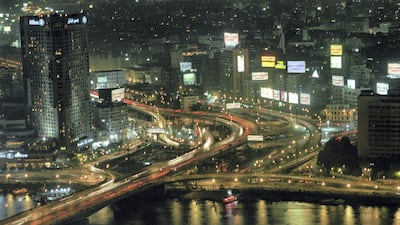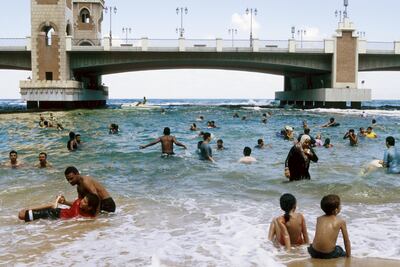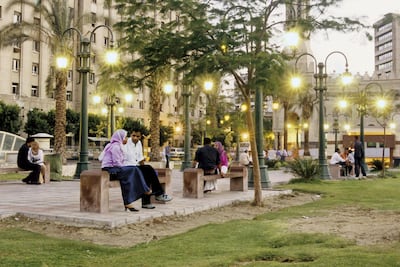In the early 2000s, the artist Maha Maamoun started researching images of the great pyramids of Egypt, as she realised that postcards always showed the monuments with expanses of desert behind them. But if you turn 45-degrees, says the Cairo-based artist, shifting in her chair to demonstrate, when The National spoke to her at Project Space Art Jameel in Dubai, "You see a totally different view. The city comes right up to their edge."
In response Maamoun began a series of works that, as she says, sought to "squeeze" images of Egypt in order to show the complexity that postcards exclude. "The touristic image of Egypt ignores the breadth and depth of the country," she says.
The result is a number of works that create and collage new images of the Egyptian capital, and which ultimately crossed paths with the Egyptian
Revolution of 2011.
In Domestic Tourism I (2005), a series of digitally altered photographs, she approached Cairo not via its fancy resorts but in the local areas frequented by members of the public.
A few years later, in the video Domestic Tourism II (2008), she noticed that Egyptian cinema was the only place where the pyramids were pictured with the city – and not the desert – behind them. And while researching these projects she came across a book, the cover of which – showing the Egyptian pyramids – enticed her to pick it up. She found a sci-fi story by the Egyptian writer Mahmoud Osman: "It was written in 2007, so already four years before the revolution, and it was predicting a revolution."
The work became Maamoun's video, 2026 (2010), that imagines time-travel and upheaval, before the events in Tahrir Square began.
Domestic Tourism I and 2026 have now been acquired by the Metropolitan Museum of Art in New York, the first in a partnership between Art Jameel and the Met Museum. Art Jameel facilitates the acquisition of Middle Eastern work to assist the Met in raising the visibility of Middle Eastern art. Antonia Carver, head of Art Jameel, says she is delighted Maamoun's works have inaugurated the programme, as they are "indicative of the considered way in which the Met curators, led by Sheena Wagstaff and Clare Davies, approach artists from this region". "We're so thrilled that this partnership allows artists from this region to be represented at one of the world's great encyclopedic museums."
The works are currently on view at Art Jameel's Project Space in Alserkal Avenue, where the Jeddah-based organisation has a temporary exhibition site until their complex is built on Deira Creek. They will also go on display at the Met in its Modern and Contemporary Art collection.
For Carver, the work is heightened by its historical urgency. "Maha's works that we're showing at Project Space Art Jameel are bold and uncompromising, yet lyrical, too. They capture a moment in Egyptian history in the mid-late 2000s, before the revolution, and succinctly yet subtly convey a sense of liminality and foreboding." Maamoun's works show the political and emotional complexity that underlies everyday events. When she came across Osman's The Revolution of 2053: The Beginning, which became the source material for 2026, she says she was struck by its failure of imagination. "The end of the novel claimed to be about the future, but it was talking about the present in journalistic terms. It was incredibly frustrating: a futuristic novel that is not able to propose a language that goes beyond the present. It felt like a dead end."
The last scene of Osman's story provides the voice-over narration of her video, while the images restage a scene from the mid-century science fiction film, La Jetée (1962), a masterpiece of French cinema. The film's protagonist travels in time to a Paris of the past – before a nuclear holocaust. Maamoun's video is disorientating, bridging together images and stories from the French and Egyptian time-travellers: whose future are we looking at? And at which present? This dislocation is a feeling that often appears in Maamoun's work. With the four photographs of Domestic Tourism I, for example, Maamoun says that she did not simply want to contest touristic images, but instead to create ones that were more complex.
"They aren't reality versus advertisement," she explains of the series. For starters, "they are all digitally altered. I wanted to get across the feeling I had in different spaces – which is sometimes an uncomfortable, tense feeling."
In Beach, she shows a public beach with people in varying degrees of dress and undress, splashing or swimming in the water, in a composite. "I photographed the same spot after time and time, bringing together people who were in this space at different times. You feel like people are in a shared space, but they are not really sharing the space. This person is right next to that one, but they have no sense of each other. A strangeness enters the picture."
Park, also in Domestic Tourism I, has a similar effect of something being just not quite right. It shows a public area off of Tahrir Square that is popular with young couples. In Egypt, "you can only have privacy by being in public," Maamoun notes. In the image couples sit together on benches. It's daylight, but the park lights are lit, twinkling brightly like exaggerated holiday decorations. "Sometimes it happens that you're walking in Cairo and you see during the day the lights are left on," Maamoun comments. "It looks a bit paranoid. The light of day is not enough – we need to have this extra light."
Maamoun's response to the Egyptian Revolution is ,"it was a major, life-shaking – though maybe not life-changing – event".
Her most recent video, Dear Animal (2016), shown at the Sharjah Art Foundation last year, suggests power relations were so up-ended by the revolution that people even started questioning the categories that separate animals from humans. In the video, a drug dealer turns into a goat-like animal, while a woman professes she was once a dolphin. "In the years after the Revolution I felt that there were these appearances of animals in the writings of people around me. I thought, why is that so, and bit by bit I felt there is a shift, a questioning, or even a disappointment in humankind."
Maamoun also recently began a book series, Kayfa Ta, or 'How to", with the artist Ala Younis. "After 2012 we thought that we need to relearn how to do things," she says. "There are new voices, new thoughts, new tools, new sentiments that we need to be able to express and show and master." It comprises four books so far. The latest, by Turkish artist Cevdet Erek, will be launched at Abu Dhabi Art in November, as part of the Droub Al Tawaya programme curated by Tarek Abou El Fetouh. The skills the books teach include How to imitate the sound of the shore using two hands and a carpet (2014).
Project Space Art Jameel, Warehouse 48, The Yard, Alserkal Avenue, September 14 to October 12, Saturday to Thursday, 10am to 6pm
______________
Read more:




